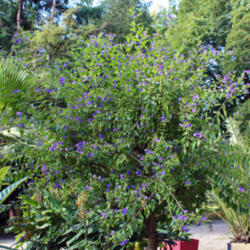| I bought a blue potato bush 6 months ago. It was pruned to appear more like a small tree than a bush. I believe this is the exact plant: Blue Potato Bush (Lycianthes rantonnetii) When I bought it, it had great purple flowers on it. Since I've moved it indoors for the winter (it's in a big pot), the flowers have disappeared. I water the plant every 2-3 days and it gets about 5 hours direct sun a day. Any ideas? I'd like to see the purple flowers again! Rich |

First, moving plants indoors from outdoors can be a real shock to their system because the conditions are usually so different. Plants may respond by yellowing and dropping leaves, reducing flowering, or going dormant. Don't fertilize for a month or so, but continue watering. In spring, slowly acclimate your plant to moving back outdoors by putting it outside in a sheltered location for a couple hours at a time, gradually increasing the time period. In fall, do that in reverse, rather than abruptly moving from outside to inside, which will help lessen the shock. Second, almost all plants have a dormant period when they don't produce flowers. Your plant blooms most vigorously during warm weather, although they can bloom almost year around. I suspect that once your plant adjusts to being indoors it will start flowering again. Finally, plants need phosphorous to bloom. You probably noticed that fertilizers have 3 numbers on the container. These numbers refer to the percentage of nitrogen (N), phosphorous (P), and potassium (K) in the fertilizer. These 3 elements are referred to as macronutrients because plants need them in fairly large (i.e., macro) amounts to thrive. How these elements interact is complicated but in general terms, nitrogen produces lush green growth, phosphorous helps strengthen stems and produce flowers (and eventually fruit), and potassium keeps the root system healthy. If you're applying fertilizer to fruiting (e.g., tomatoes) or flowering plants, you're not as interested in the plant developing leaves as you are in it flowers and fruit, so you'd use a formulation lower in nitrogen and higher in phosphorous, such as Miracle-Gro's Plant Food at 15-30-15. Bone meal is an organic source of phosphorous. After you plant adjusts to the indoors, start a regular fertilizing program. Potted plant roots can't seek out additional nutrients from surrounding soil. Here's some organic sources of NPK if you prefer. Nitrogen: alfalfa meal, blood meal, coffee grounds, cottonseed meal, fish emulsion, seabird guano. Phosphorous: bone meal, rock phosphate Potassium: greensand, seaweed, kelp Be careful not to overwater. Always check the soil before you water and water only if it feels dry a couple inches below the surface. A slow, deep infrequent watering better than frequent light watering. Leach salts at least once a month by letting water run through the pot. I hope this info helps! |